انقلاب گواتيمالا 1954
| انقلاب گواتيمالا 1954 | ||||||||
|---|---|---|---|---|---|---|---|---|
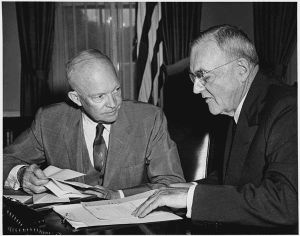 الرئيس الأمريكي دوايت أيزنهاور ووزير خارجيته جون فوستر دلس، المؤيد للانقلاب الگواتيمالي 1954 الذي نصّب ديكتاتورية يمينية. | ||||||||
| ||||||||
| المتحاربون | ||||||||
|
|
|
| ||||||
| القادة والزعماء | ||||||||
|
خاكوبو آربنز كارلوس إنريكى دياز |
كارلوس كاستيو أرماس دوايت أيزنهاور ألن دلس | |||||||
الانقلاب الگواتيمالي 1954 كان عملية سرية قامت بها وكالة المخابرات المركزية الأمريكية (CIA) أطاحت بالرئيس الگواتيمالي المنتخب ديمقراطياً خاكوبو آربنز وأنهت الحكومة الگواتيمالية 1944–54. الاسم الرمزي للعملية كان Operation PBSUCCESS، والتي نصّبت الديكتاتورية العسكرية بقيادة كارلوس كاستيو أرماس، الأول في سلسلة من الحكام السلطويين المدعومين من الولايات المتحدة في گواتيمالا.
بدأت الثورة الگواتيمالية في 1944، حين أطاحت انتفاضة شعبية بالرئيس المتسلط خورخى أوبيكو وجلبت خوان خوسيه أريڤالو إلى السلطة عبر أول انتخابات ديمقراطية في گواتيمالا. قدّم الرئيس الجديد الحد الأدنى للأجور وما يقرُب من الحق الشامل للاقتراع, aiming to turn Guatemala into a الديمقراطية الليبرالية. Arévalo was succeeded by Árbenz in 1951, who instituted popular الاصلاح الزراعي which granted property to landless peasants.[1] الثورة الگواتيمالية was disliked by the United States government, which was predisposed by the الحرب الباردة to see it as communist. This perception grew after Árbenz took power وأسبغ الشرعية على الحزب الشيوعي. شركة يونايتد فروتس (UFC), whose highly profitable business had been affected by the end to exploitative labor practices in Guatemala, also disliked the Revolution, and engaged in an influential lobbying campaign to persuade the U.S. للاطاحة بالحكومة الگواتيمالية. الرئيس الأمريكي هاري ترومان authorized Operation PBFORTUNE للاطاحة بآربنز في 1952؛ بالرغم من أن العملية أُجهِضت بسرعة، إلا أنها كانت إرهاصة للعملية PBSUCCESS.
دوايت أيزنهاور was elected U.S. President in 1952, promising to take a harder line ضد الشيوعية; the links that his staff members جون فوستر دلس و آلن دلس had to the UFC also predisposed them to act against the Guatemalan government. Additionally, the U.S. government drew exaggerated conclusions about the extent of communist influence from the presence of a small number of communists among Árbenz's advisers. Eisenhower authorized the CIA to carry out Operation PBSUCCESS in August 1953. The CIA armed, funded, and trained a force of 480 men led by Carlos Castillo Armas. The coup was preceded by U.S. efforts to criticize and isolate Guatemala internationally. Castillo Armas' force invaded Guatemala on 18 June 1954, backed by a heavy campaign of psychological warfare. This included a radio station which broadcast anti-government propaganda and a version of military events favorable to the rebellion, claiming to be genuine news, as well as bombings of Guatemala City and a naval blockade of Guatemala. The invasion force fared poorly militarily, and most of its offensives were defeated. However, psychological warfare and the possibility of a U.S. invasion intimidated the Guatemalan army, which eventually refused to fight. Árbenz briefly and unsuccessfully attempted to arm civilians to resist the invasion, before resigning on 27 June. Castillo Armas became president ten days later, following negotiations in San Salvador.
Described as the definitive deathblow to democracy in Guatemala, the coup was widely criticized internationally, and contributed to long-lasting anti-U.S. sentiment in Latin America. Attempting to justify the coup, the CIA launched Operation PBHISTORY, which sought evidence of Soviet influence in Guatemala among documents from the Árbenz era: the effort was a failure. Castillo Armas quickly assumed dictatorial powers, banning opposition parties, imprisoning and torturing political opponents, and reversing the social reforms of the Revolution. Nearly four decades of civil war followed, as leftist guerrillas fought a series of U.S.-backed authoritarian regimes whose brutalities included a genocide of the Maya peoples.
. . . . . . . . . . . . . . . . . . . . . . . . . . . . . . . . . . . . . . . . . . . . . . . . . . . . . . . . . . . . . . . . . . . . . . . . . . . . . . . . . . . . . . . . . . . . . . . . . . . . . . . . . . . . . . . . . . . . . . . . . . . . . . . . . . . . . . . . . . . . . . . . . . . . . . . . . . . . . . . . . . . . . . . .
خلفية تاريخية
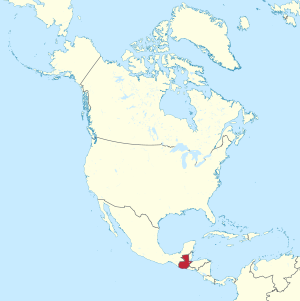
مبدأ مونرو
الحكومات السلطوية وشركة يونايتد فروتس
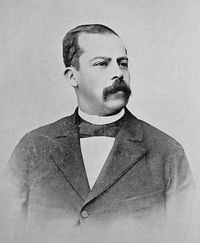
الثورة الگواتيمالية ورئاسة أريڤالو
The repressive policies of the Ubico government resulted in a popular uprising led by university students and middle-class citizens in 1944.[2] Ubico fled, handing over power to a three-person junta which continued Ubico's policies until it too was toppled, by the ثورة أكتوبر that aimed to transform Guatemala into a liberal democracy.[2] The largely free election that followed installed a philosophically conservative university professor, Juan José Arévalo, as the President of Guatemala. Arévalo's administration drafted a more liberal labor code, built health centers, and increased funding to education.[3][4] Arévalo enacted a minimum wage, and created state-run farms to employ landless laborers. He also cracked down on the communist Guatemalan Party of Labour (Partido Guatemalteco del Trabajo, PGT) and in 1945 criminalized all labor unions in workplaces with fewer than 500 workers.[5] By 1947, the remaining unions had grown strong enough to pressure him into drafting a new labor code, which made workplace discrimination illegal and created health and safety standards.[6] However, Arévalo refused to advocate land reform of any kind, and stopped short of drastically changing labor relations in the countryside.[3]
رئاسة آربنز والإصلاح الزراعي
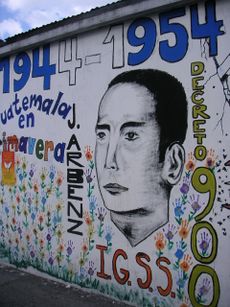
Genesis and prelude
ضغوط شركة يونايتد فروتس

ادارة آيزنهاور
العملية PBSUCCESS
التخطيط
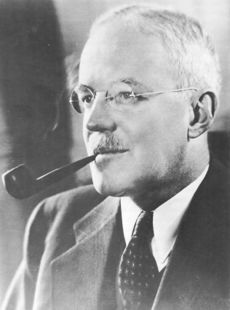
غزو كاستيو أرماس
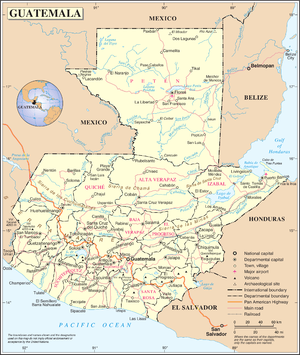
. . . . . . . . . . . . . . . . . . . . . . . . . . . . . . . . . . . . . . . . . . . . . . . . . . . . . . . . . . . . . . . . . . . . . . . . . . . . . . . . . . . . . . . . . . . . . . . . . . . . . . . . . . . . . . . . . . . . . . . . . . . . . . . . . . . . . . . . . . . . . . . . . . . . . . . . . . . . . . . . . . . . . . . .
الأعقاب
الحرب الأهلية
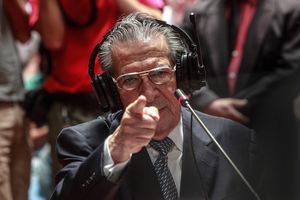
اعتذارات
انظر أيضاً
ملاحظات وهوامش
ملاحظات
الهامش
- ^ Handy 1994, p. 4.
- ^ أ ب Streeter 2000, pp. 12–13.
- ^ أ ب Streeter 2000, pp. 14–15.
- ^ Jiménez 1985, p. 149.
- ^ Forster 2001, pp. 98–99.
- ^ Forster 2001, pp. 99–101.
ببليوجرافيا
- Bartrop, Paul R.; Jacobs, Steven Leonard (2015). Modern Genocide: The Definitive Resource and Document Collection. Santa Barbara, California: ABC-CLIO. ISBN 978-1-61069-364-6.
{{cite book}}: Invalid|ref=harv(help) - Blum, William (2003). Killing Hope: US Military and CIA Interventions Since World War II. لندن: Zed Books. ISBN 978-1-84277-369-7.
{{cite book}}: Invalid|ref=harv(help) - Broder, John M. (11 March 1999). "Clinton Offers His Apologies to Guatemala". The New York Times. Retrieved 14 August 2016.
{{cite news}}: CS1 maint: ref duplicates default (link) - Castañeda, Manolo E. Vela (2005). "Guatemala 1954: Las ideas de la contrarrevolución". Foro Internacional (in الإسبانية). 45 (1): 89–114. JSTOR 27738691.
{{cite journal}}: Invalid|ref=harv(help) - Chapman, Peter (2007). Bananas!: How the United Fruit Company Shaped the World. New York City, New York: Canongate Books. ISBN 1-84195-881-6.
{{cite book}}: Invalid|ref=harv(help) - Cullather, Nicholas (1994). Operation PBSUCCESS: The United States and Guatemala, 1952–1954. Center for the Study of Intelligence, Central Intelligence Agency.
{{cite book}}: Invalid|ref=harv(help) - Cullather, Nicholas (2006). Secret History: The CIA's classified account of its operations in Guatemala, 1952–1954. Palo Alto, California: Stanford University Press. ISBN 978-0-8047-5468-2.
{{cite book}}: Invalid|ref=harv(help) - Figueroa Ibarra, Carlos (May–August 2006). "Izquierda y violencia revolucionaria en Guatemala (1954–1960)". Fermentum (in الإسبانية). 16 (46): 395–414.
{{cite journal}}: Invalid|ref=harv(help) - Figueroa Ibarra, Carlos (January–February 1990). "Guatemala el recurso del miedo". Nueva Sociedad (105): 108–117.
{{cite journal}}: Invalid|ref=harv(help) - Forster, Cindy (2001). The Time of Freedom: Campesino Workers in Guatemala's October Revolution. Pittsburgh, Pennsylvania: University of Pittsburgh Press. ISBN 978-0-8229-4162-0.
{{cite book}}: Invalid|ref=harv(help) - Fraser, Andrew (21 August 2005). "Architecture of a broken dream: The CIA and Guatemala, 1952–54". Intelligence and National Security. 20 (3): 486–508. doi:10.1080/02684520500269010.
{{cite journal}}: Invalid|ref=harv(help) - Gaddis, John Lewis (2006). The Cold War: A New History. New York City, New York: Penguin Books. ISBN 978-0-14-303827-6.
{{cite book}}: Invalid|ref=harv(help) - Gilderhus, Mark T. (March 2006). "The Monroe Doctrine: Meanings and Implications". Presidential Studies Quarterly. 36 (1): 5–16. doi:10.1111/j.1741-5705.2006.00282.x. JSTOR 27552742.
{{cite journal}}: Invalid|ref=harv(help) - Gleijeses, Piero (1991). Shattered Hope: The Guatemalan Revolution and the United States, 1944–1954. Princeton, New Jersey: Princeton University Press. ISBN 978-0-691-02556-8.
{{cite book}}: Invalid|ref=harv(help) - Gordon, Max (Summer 1971). "A Case History of U. S. Subversion: Guatemala, 1954". Science and Society. 35 (2): 129–155. JSTOR 40401561.
{{cite journal}}: CS1 maint: ref duplicates default (link) - Grandin, Greg (2000). The Blood of Guatemala: A History of Race and Nation. Durham, North Carolina: Duke University Press. ISBN 978-0-8223-2495-9.
{{cite book}}: Invalid|ref=harv(help) - Grandin, Greg (2004). The Last Colonial Massacre. Chicago, Illinois: University of Chicago Press. ISBN 0-226-30572-4.
{{cite book}}: Invalid|ref=harv(help) - Gruson, Sydney (9 July 1954). "Useless Weapons and Duds Sent Guatemala by Reds, Officers Say; REDS SENT DUDS TO GUATEMALANS". The New York Times. ISSN 0362-4331. Retrieved 13 August 2016.
{{cite news}}: CS1 maint: ref duplicates default (link) - Haines, Gerald (June 1995). "CIA and Guatemala Assassination Proposals, 1952–1954" (PDF). CIA Historical Review Program.
{{cite web}}: CS1 maint: ref duplicates default (link) - Handy, Jim (1994). Revolution in the Countryside: Rural Conflict and Agrarian Reform in Guatemala, 1944–1954. Chapel Hill, North Carolina: University of North Carolina Press. ISBN 978-0-8078-4438-0.
{{cite book}}: Invalid|ref=harv(help) - Harbury, Jennifer (2005). Truth, Torture, and the American Way: The History and Consequences of U.S. Involvement in Torture. Boston, Massachusetts: Beacon Press. ISBN 978-0-8070-0307-7.
{{cite book}}: Invalid|ref=harv(help) - Holland, Max (2004). "Operation PBHISTORY: The Aftermath of SUCCESS". International Journal of Intelligence and CounterIntelligence. 17 (2): 300–332. doi:10.1080/08850600490274935.
{{cite journal}}: Invalid|ref=harv(help) - Holland, Max (1 January 2005). "Private Sources of U.S. Foreign Policy: William Pawley and the 1954 Coup d'Etat in Guatemala". Journal of Cold War Studies. 7 (4): 36–73. ISSN 1531-3298 – via Project MUSE.
{{cite journal}}: Invalid|ref=harv(help); Unknown parameter|subscription=ignored (|url-access=suggested) (help) - Hove, Mark T. (September 2007). "The Arbenz Factor: Salvador Allende, U.S.-Chilean Relations, and the 1954 U.S. Intervention in Guatemala". Diplomatic History. 31 (4): 623–663.
{{cite journal}}: Invalid|ref=harv(help) - Immerman, Richard H. (1982). The CIA in Guatemala: The Foreign Policy of Intervention. Austin, Texas: University of Texas Press.
{{cite book}}: Invalid|ref=harv(help) - Jiménez, Hugo Murillo (1985). "La intervención Norteamericana en Guatemala en 1954: Dos interpretacines". Anuario de Estudios Centroamerica. 11 (2): 149–155.
{{cite journal}}: Invalid|ref=harv(help) - Kornbluh, Peter; Doyle, Kate, eds. (23 May 1997), "CIA and Assassinations: The Guatemala 1954 Documents", National Security Archive Electronic Briefing Book No. 4 (Washington, D.C.: National Security Archive), http://www.gwu.edu/~nsarchiv/NSAEBB/NSAEBB4/index.html
- LaFeber, Walter (1993). Inevitable Revolutions: The United States in Central America. New York City, New York: W. W. Norton & Company. ISBN 0-393-03434-8.
{{cite book}}: Invalid|ref=harv(help) - May, Rachel (March 1999). ""Surviving All Changes Is Your Destiny": Violence and Popular Movements in Guatemala". Latin American Perspectives. 26 (2): 68–91. doi:10.1177/0094582x9902600204.
{{cite journal}}: Invalid|ref=harv(help) - Malkin, Elisabeth (20 October 2011). "An Apology for a Guatemalan Coup, 57 Years Later". The New York Times.
{{cite news}}: CS1 maint: ref duplicates default (link) - McAllister, Carlota (2010). "A Headlong Rush into the Future". In Grandin, Greg; Joseph, Gilbert (eds.). A Century of Revolution. Durham, North Carolina: Duke University Press. pp. 276–309. ISBN 978-0-8223-9285-9. Retrieved 14 January 2014.
{{cite encyclopedia}}: CS1 maint: ref duplicates default (link) - McCleary, Rachel M. (1999). Dictating Democracy: Guatemala and the End of Violent Revolution. Gainesville, Florida: University Press of Florida. ISBN 978-0-8130-1726-6. Retrieved 3 January 2017.
{{cite book}}: Invalid|ref=harv(help) - Mikaberidze, Alexander (2013). Atrocities, Massacres, and War Crimes: An Encyclopedia. Santa Barbara, California: ABC-CLIO, LLC. ISBN 978-1-59884-926-4.
{{cite book}}: Invalid|ref=harv(help) - Navarro, Mireya (26 February 1999). "Guatemalan Army Waged 'Genocide,' New Report Finds". The New York Times. Retrieved 20 November 2016.
{{cite news}}: Invalid|ref=harv(help) - "Historical Overview of Pentecostalism in Guatemala". Pew Research Center. 5 October 2006.
- Schlesinger, Stephen; Kinzer, Stephen (1999). Bitter Fruit: The Story of the American Coup in Guatemala. Cambridge, Massachusetts: Harvard University Press. ISBN 978-0-674-01930-0.
{{cite book}}: Invalid|ref=harv(help) - Smith, Gaddis (30 November 1995). The Last Years of the Monroe Doctrine, 1945–1993. New York City, New York: Hill and Wang. ISBN 978-0-8090-1568-9.
{{cite book}}: Invalid|ref=harv(help) - Streeter, Stephen M. (2000). Managing the Counterrevolution: The United States and Guatemala, 1954–1961. Athens, Ohio: Ohio University Press. ISBN 978-0-89680-215-5.
{{cite book}}: Invalid|ref=harv(help) - Young, John W. (1986). "Great Britain's Latin American Dilemma: The Foreign Office and the Overthrow of 'Communist' Guatemala, June 1954". The International History Review. 8 (4): 573–592 [p. 584]. doi:10.1080/07075332.1986.9640425.
{{cite journal}}: Invalid|ref=harv(help)
. . . . . . . . . . . . . . . . . . . . . . . . . . . . . . . . . . . . . . . . . . . . . . . . . . . . . . . . . . . . . . . . . . . . . . . . . . . . . . . . . . . . . . . . . . . . . . . . . . . . . . . . . . . . . . . . . . . . . . . . . . . . . . . . . . . . . . . . . . . . . . . . . . . . . . . . . . . . . . . . . . . . . . . .
للاستزادة
- Handy, Jim (1994). Revolution in the Countryside: Rural Conflict and Agrarian Reform in Guatemala 1944–54. Chapel Hill: University of North Carolina Press. ISBN 0-8078-4438-1.
- Shea, Maureen E (2001). Standish, Peter (ed.). Culture and Customs of Guatemala. Culture and Customs of Latin American and the Caribbean. London: Greenwood Press. ISBN 0-313-30596-X.
- Shillington, John (2002). Grappling with Atrocity: Guatemalan Theater in the 1990s. Fairleigh Dickinson University Press. ISBN 978-0-8386-3930-6.
وصلات خارجية
- CIA Freedom of Information Act Electronic Reading Room – CIA's declassified documents on Guatemala CIA Documents Chronicling the 1954 Coup
- US State Dept. site – Foreign Relations, 1952–1954: Guatemala
- American Accountability Project at the Wayback Machine (archived 30 أكتوبر 2005) – The Guatemala Genocide
- Guatemala Documentation Project – Provided by the National Security Archive.
- Video: Devils Don't Dream! Analysis of the CIA-sponsored 1954 coup in Guatemala.
- The Guatemala 1954 Documents
- الفيلم القصير U.S. Warns Russia to Keep Hands off in Guatemala Crisis (1955) متاح للتنزيل المجاني على أرشيف الإنترنت [more]
- U.S. Congressional involvement in the coup
- Articles with hatnote templates targeting a nonexistent page
- CS1 maint: ref duplicates default
- CS1 الإسبانية-language sources (es)
- CS1 errors: unsupported parameter
- انقلابات ومحاولات انقلاب عقد 1950
- الانقلابات العسكرية في گواتيمالا
- 1954 في گواتيمالا
- عمليات وكالة المخابرات المركزية
- الثورة الگواتيمالية
- الحرب الباردة في أمريكا اللاتينية
- نزاعات الحرب الباردة
- نزاعات 1954
- أحداث يونيو 1954
- تاريخ الولايات المتحدة (1945–64)
- عمليات رايات كاذبة
- إمبريالية


